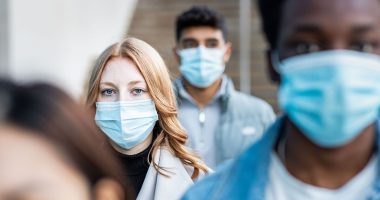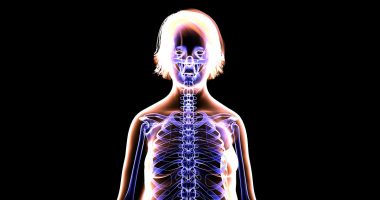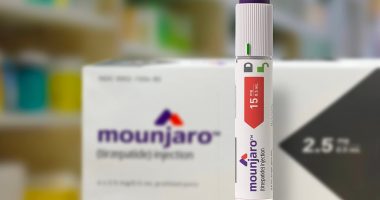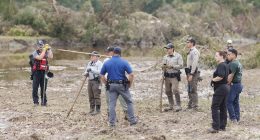Share this @internewscast.com
The phrase ‘no pain, no gain’ has been heard across gym floors for decades as a source of motivation – but what if that pain is actually your body begging you to stop?
Mother-of-two Ruta, from Boston, had the shock of her life after receiving a call from her doctor while sitting on a plane bound for Frankfurt.
Earlier that week, Ruta had tried out a group strength training class called Upper Body Burnout – a buzzy new workout designed to push the upper body muscles to their limit through high-repetition exercises.
When she returned the next day, she could barely get past the first five minutes due to pain and exhaustion. In fact, her triceps were so sore, she couldn’t even lift her arms to wash her hair.
Still, the peppy instructor urged her to keep pushing herself – so she did.
The weekend rolled around and she had a few glasses of wine that didn’t sit well with her as she felt dehydrated. She also looked quite sunburned.
‘By Sunday both of my arms swelled up,’ adds Ruta. It was a worrying collection of symptoms, so she decided to see a doctor with her trip to Germany imminent.
‘My doctor thought it was strange to have arms swollen like that but said it was most likely due to the sunburn,’ Ruta says.

Mother-of-two Ruta, from Boston, was saved by a phone call from her doctor before catching a flight to Germany. Bloodwork showed she had rhabdomyolysis – often called ‘rhabdo’ for short

Days earlier, Ruta had joined an Upper Body Burnout class. It was intense. However, the feeling of exhaustion afterwards was not normal – it was a sign of a potentially deadly condition
‘But just to be safe, he ordered bloodwork to test my liver panel. He said, “Go ahead and enjoy your vacation unless you hear from me.” Since I didn’t hear from him, I ended up getting on a flight.
‘As the plane started taxiing from the gate, my doctor called me and said I needed to get off the flight immediately and head to the emergency room. They were waiting for me.’
That phone call saved Ruta’s life.
She was suffering from the little-known, but extremely serious, condition known as rhabdomyolysis – often called ‘rhabdo’ for short.
Rhabdo occurs when muscle tissue breaks down rapidly and releases substances into the bloodstream. It is often caused by traumatic injuries – like electrical shock or being crushed – but it can also be triggered by intense exercise and muscle strain.
Specialist Dr Sarah Wood tells me common symptoms of rhabdo include pain in the muscles that were heavily exercised and dark brown or red urine.
Ruta was in hospital for three days and was kept on a strong IV drip to flush the toxins out of her kidneys.

Julie Gollnick also developed rhabdo in 2023 after a CrossFit class – despite working out daily

The 45-year-old mother, from New Jersey, had no idea what was causing the swelling and her partner suggested she go to the emergency room. She spent six days in the hospital

‘My arm was sore in a way that I had never felt before and started to massively swell,’ she says. (Julie’s swollen arm, caused by rhabdomyolysis, is shown here)
‘I was shocked by how few people are aware of it – including my trainer at a specialised gym who had never heard of it either,’ she tells me.
‘I recovered fully with no permanent kidney damage, but if I had taken that flight I would have likely ended up on dialysis. The worst-case scenario is I would have not survived the eight-hour flight. So I was literally saved by that phone call!’
Fitness coach Julie Gollnick also had rhabdomyolysis in 2023.
Despite working out every day and being used to physical exertion, one particularly intense gym class was enough to trigger the potentially deadly condition.
On August 19, 2023, she attended a CrossFit class which left her feeling ‘super strong and impressed’ with herself – but things took a turn three days later.
‘Over the next couple days, I felt normal soreness. Then on the Tuesday, the soreness in my arms felt super tight and my range of motion was decreasing. I couldn’t put my hair back or comfortably touch my face,’ she says.
‘My arm was sore in a way that I had never felt before and started to massively swell. It was so wild because I was at a lunch meeting and could not get my fork to my mouth. It was affecting my mobility.’
The 45-year-old mother, from New Jersey, had no idea what was causing the swelling and her partner suggested she go to the emergency room.
‘The doctors did not equate the swelling to rhabdo and originally didn’t think that was what it was. But the urine and blood tests showed elevated CK (creatine kinase) levels and liver enzymes,’ she recalls. These are common signs of the condition.
‘While I had done many hard workouts before, this one stood out as possibly the hardest one I ever did.
‘Later, the nephrologist [a specialist in kidney disease] said it would be very unlikely I develop it again, but told me to be aware of workouts of such extreme intensity.’
The specialist explained how ‘normal’ CK levels teeter around 34-145 units per litre, but Julie’s had skyrocketed to 39,000 u/L.
Julie remained in hospital for six days and was discharged when her CK levels returned to a normal level.
‘My advice is to absolutely do challenging workouts, but if you’re doing something very intense at a fast pace, you may be too distracted in the moment to realise the workout is too much. Stay hydrated and listen to your body,’ she says.
In January, Jack Gipson was preparing to compete in a marathon and was running between 112km and 144km per week in the lead-up to the race.
The day before the event, he started to feel ‘off’.
‘I didn’t know it yet but I had developed the flu. I tried to run the marathon and made it 17 miles (27km) before my body gave out and I was taken by ambulance to the hospital,’ Jack, from Texas, tells me.
‘The flu plus hypothermia ended up putting so much stress on my body – and on top of it all, I developed rhabdo.’
He had a high fever of 103°F (39°C), extreme body aches, nausea, vomiting and he couldn’t move without assistance.
Jack remained in hospital for two days then was sent home to rest for another week and a half before he was able to return to work.

In January this year, Jack Gipson (pictured) was in hospital for two days with rhabdomyolysis after training for a marathon
‘Doctors originally didn’t want me to exercise for a while. I took two weeks off and went to see the doctors as I was still having wheezing problems because I also have asthma,’ he said.
‘They told me I was very quick to start training again compared to what other individuals usually can do.’
‘Ever since the incident, I haven’t had any long-term effects and have been running and working out like normal,’ he adds.
‘It was a rough time when I had it, but I am glad to be through it. I do think we, as a general public, should be more educated on the dangers of it.’
What causes rhabdomyolysis?

Dr Sarah Wood (pictured) said the causes of rhabdo can vary, but the most common are extreme exercise and overexertion
The causes for this condition can vary, but the most common are extreme exercise and overexertion – particularly in hot weather.
Dr Wood agrees, telling me: ‘Clinically, most of what I’ve seen as a GP is following significant exercise, especially in the context of dehydration.
‘A classic example is someone who isn’t very active deciding to run a half marathon the day after a night in the pub.
‘Another common clinical picture seen in hospitals can be older people who’ve fallen and had a “long lie” – that extended time before being helped.
‘Generally, it involves some kind of trauma to the muscles – whether that’s unusual exercise, burns, a crush injury or even sometimes a viral illness.’
Other causes of rhabdo include alcohol and drug use (both prescribed and recreational), and severe infections.
What to do if you have symptoms
‘The two biggest factors are hydration and removing the cause, if it’s ongoing,’ Dr Wood advises.
‘From the hydration perspective, think of it as flushing out the system. The cell components released into the bloodstream can damage the kidneys and other organs, so diluting these helps.
‘Recovery takes time, and adequate protein to rebuild the muscle.’
Above all, if symptoms persist, seek medical attention immediately and do not delay.

















